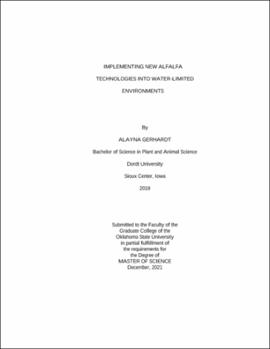| dc.description.abstract | Oklahoma is predicted to experience a shift in rainfall patterns and experience prolonged droughts in future years. With a changing environment, producers will search for new technologies to mitigate forage losses in this area. New technologies that could be incorporated into Oklahoma alfalfa production include reduced lignin alfalfa cultivars and yield prediction models. While reduced lignin alfalfa cultivars are considered beneficial in other regions, their performance is unknown in water-limited environments, such as the central Great Plains (CGP). Also, the development of alfalfa yield predicting models would allow producers to make management decisions that best suit their hay and cattle enterprises. The object of this study was (i) to compare aboveground biomass (AGB), crude protein (CP), neutral detergent fiber (NDF), acid detergent lignin (ADL), and in vitro dry matter digestibility 48 hours (IVTDMD) among reduced lignin (54HVX41) and three reference alfalfas (54VR10, DKA44-16RR, WL 356 HQ.RR) at 28-d, 35-d, and 48-d harvest intervals in two locations (Lahoma and Stillwater, OK), and (ii) to test plant height (PH), grazing height (GH), compressed canopy height (CCH), green canopy cover (GCC), and growing degree days (GDD) as predictive variables of alfalfa aboveground biomass (AGB) to develop a producer-friendly alfalfa prediction model for the CGP. No statistical differences in AGB were observed in either locations across harvest intervals and cultivars. Overall, CP, NDF content, and IVTDMD results varied according to the ADL content changes in cultivars and harvest intervals. In Lahoma, the reduced lignin alfalfa had less ADL content than all reference cultivars. In contrast, no significant differences in ADL content were observed in Stillwater, where drought was observed. We speculate that reference cultivars may accumulate less lignin content, resulting in values similar to the reduced lignin alfalfa during drought conditions. Furthermore, GH and GDD were selected to be the primary and secondary independent AGB predictors; however, sixteen distinct linear models were proposed due to high cultivar x harvest interval variability. Further statistical analysis and site-years data are necessary to incorporate GCC and improve GDD as predicting variables. | |
